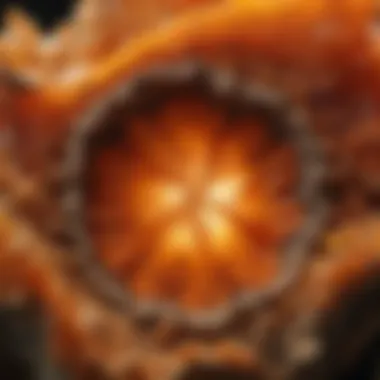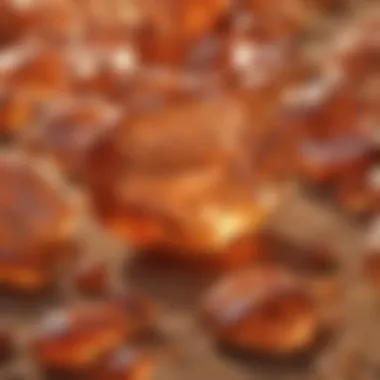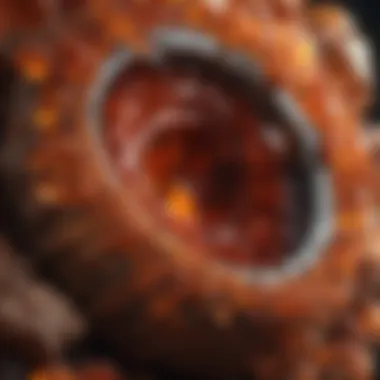Unraveling the Enigmatic Beauty of Orange Rocks and Minerals


Rock and Fossil Identification
Orange rocks and minerals are a fascinating subset of geological specimens known for their vibrant hues and intricate formations. When delving into the world of orange rocks, it is essential to understand the various types of rocks and fossils that fall into this category. From agates to carnelian, each type possesses unique characteristics that make them distinguishable. Attributes such as color intensity, texture, and crystalline structure are key factors to look for when identifying these geological wonders. Utilizing tools such as hand lenses and streak plates can aid in the precise identification of orange rocks and minerals, enhancing the collector's ability to distinguish between different specimens.
Introduction to Orange Rocks and Minerals
Orange rocks and minerals hold a unique fascination in the realm of geology, offering a vibrant display of nature's ingenuity. This section serves as a gateway to the intricate world of orange-hued geological wonders. By delving into the defining features, geological significance, and historical context of these rocks and minerals, readers can gain a comprehensive understanding of their place in the Earth's vast tapestry.
Defining Orange Rocks and Minerals
Characteristic Color Features
The characteristic color features of orange rocks and minerals stand out as a defining attribute that sets them apart in the geological spectrum. Vibrant hues of orange, ranging from pale citrine to deep carnelian, are not only visually striking but also indicative of specific mineral compositions. The warm and inviting tones of these rocks make them popular choices for collectors and enthusiasts alike, adding a pop of color to any collection. Despite their appeal, the color intensity can sometimes vary due to external factors like environmental conditions and mineral impurities, offering a nuanced palette for exploration.
Chemical Composition
The chemical composition of orange rocks and minerals plays a pivotal role in shaping their physical properties and overall characteristics. Comprised of elements such as iron oxides, manganese, and silica, these minerals exhibit a diverse range of compositions that contribute to their unique colors and textures. Understanding the chemical makeup of these specimens not only aids in their identification but also sheds light on their formation processes and geological origins. While certain compositions may lend durability and luster to the rocks, others can render them more prone to weathering or degradation over time, making for a fascinating study of mineral chemistry.
Significance in Geology
Impact on Geological Formations
Orange rocks and minerals hold significant importance in shaping geological formations due to their distinctive properties and compositions. Through their interactions with surrounding rocks and minerals, orange specimens contribute to the vibrant mosaic of the Earth's crust, influencing the formation of intriguing structures and landscapes. From sedimentary layers enriched with iron oxide pigments to volcanic deposits rich in orange-colored crystals, these geological formations offer valuable insights into the history and evolution of our planet.
Identification in Nature
The identification of orange rocks and minerals in nature presents a captivating challenge for geologists and rock enthusiasts. By honing observational skills and utilizing field techniques, researchers can pinpoint specific mineral specimens amidst diverse geological settings. Whether through visual cues like color intensity and crystal structures or advanced analytical methods such as spectroscopy and X-ray diffraction, the process of identifying orange minerals offers a blend of art and science. This pursuit not only enhances our understanding of geological processes but also underscores the intricate relationship between minerals and their natural environments.
Cultural and Historical Significance
Ancient Uses and Beliefs
The ancient uses and beliefs surrounding orange rocks and minerals provide a window into the cultural practices and symbolism of past civilizations. From ancient ritualistic ceremonies to medicinal applications, these minerals played a prominent role in shaping human interactions with the natural world. Believed to possess mystical properties and healing energies, orange-hued stones were revered for their supposed connections to the sun and fire, embodying concepts of warmth, vitality, and protection. By exploring the historical narratives and archaeological remnants associated with these minerals, we glimpse into the deep-rooted traditions and beliefs that underscore their cultural significance.
Modern Interpretations
In modern times, orange rocks and minerals continue to capture the imagination of scholars, artists, and metaphysical enthusiasts alike, fueling diverse interpretations and creative expressions. From contemporary art installations to alternative healing therapies, the allure of orange-hued specimens transcends traditional boundaries, sparking innovation and exploration. While some embrace the vibrant energies of these minerals for decorative purposes and aesthetic appeal, others delve into their metaphysical properties and spiritual meanings, seeking balance and inspiration in their presence. The modern interpretations of orange rocks and minerals reflect a fusion of tradition and innovation, bridging the past with the present in a dynamic tapestry of cultural appreciation.
Formation and Properties of Orange Rocks and Minerals
Orange rocks and minerals constitute a mesmerizing array of geological specimens that boast unique formations and intriguing properties. Within the realm of this article, the exploration of these orange-hued wonders serves as a cornerstone for understanding their significance in the broader context of Earth's geological tapestry. By delving into the specifics surrounding the formation processes and inherent properties of these rocks and minerals, enthusiasts and collectors can gain profound insights into their genesis and characteristics.
Origins and Geological Processes
Formation mechanisms
The formation mechanisms of orange rocks and minerals unveil a captivating narrative of geological evolution. Through the intricate interplay of various geological forces and chemical processes, these entities come into existence, showcasing the complexity of Earth's natural history. The key characteristic of these formation mechanisms lies in their ability to produce a diverse range of orange hues, reflecting the diverse mineral compositions involved. Understanding these mechanisms offers invaluable insights into the conditions that lead to the creation of such unique geological specimens.
Environments of occurrence


The environments in which orange rocks and minerals occur play a pivotal role in shaping their distinct features. Whether nestled deep within mountain ranges or scattered across arid deserts, these minerals are a testament to the diversity of Earth's geological landscapes. The key characteristic of these environments lies in their ability to provide the necessary conditions for the crystallization and aggregation of minerals, culminating in the vibrant orange hues that captivate collectors worldwide. Exploring these environments offers a glimpse into the intricate interplay of geological forces at work.
Distinctive Characteristics
Crystal structures
The crystal structures of orange rocks and minerals serve as a testament to the intricate patterns that define their visual allure. From the mesmerizing symmetry of quartz formations to the complex interlocking of feldspar crystals, these structures hold a unique fascination for rock and mineral enthusiasts. The key characteristic of these crystal structures lies in their ability to refract light in ways that imbue the minerals with their vibrant orange hues, creating a visual spectacle that mesmerizes all who behold them.
Physical properties
The physical properties of orange rocks and minerals encompass a wide range of attributes that speak to their geological origins and structural integrity. From hardness and cleavage to luster and specific gravity, these properties offer valuable insights into the durability and composition of these geological treasures. The key characteristic of these physical properties lies in their ability to provide clues about the mineral's formation conditions and history, allowing collectors to unravel the mysteries contained within each specimen.
Rare and Valuable Varieties
Exceptional specimens
Exceptional specimens of orange rocks and minerals represent the pinnacle of geological artistry, showcasing rare formations and unparalleled beauty. From intricately veined agates to vibrant fire opals, these specimens command attention and admiration from collectors worldwide. The key characteristic of these exceptional specimens lies in their rarity and aesthetic appeal, making them highly sought after in the world of mineral collecting. Acquiring such specimens elevates any collection, adding a touch of exclusivity and sophistication.
Market demand
The market demand for orange rocks and minerals reflects the growing appreciation for these geological wonders among collectors and enthusiasts. As more individuals recognize the intrinsic beauty and rarity of these specimens, the demand for high-quality orange-hued minerals continues to rise. The key characteristic of this market demand lies in its ability to fuel a thriving industry centered around the acquisition and trade of these geological treasures. Understanding the market dynamics offers insights into the evolving trends and preferences within the world of mineral collecting.
Popular Types of Orange Rocks and Minerals
Orange rocks and minerals have long captivated enthusiasts and collectors alike with their vibrant hues and unique properties, offering a treasure trove of geological wonders to explore. In this section, we delve into the significance of popular types of orange rocks and minerals within the broader context of our article, highlighting their specific characteristics, benefits, and considerations.
Carnelian
Carnelian, a popular type of orange rock, stands out for its distinctive characteristics and variations, making it a sought-after choice among collectors and jewelry enthusiasts. Exploring the nuances of its characteristics and variations sheds light on its value in the world of minerals.
Characteristics and Variations
Carnelian's characteristic deep orange to reddish-brown hues, often displaying translucent to opaque qualities, set it apart from other minerals. Its smooth texture and waxy luster enhance its visual appeal, making it a popular choice for adornment and ornamental purposes. The unique banded patterns and inclusions found in carnelian add to its allure, creating a stunning visual display that appeals to collectors seeking beauty and uniqueness in their specimens.
Uses in Jewelry and Decor
The versatility of carnelian extends beyond its aesthetic appeal, as it serves various purposes in jewelry and decor. Its hardness and durability make it suitable for carving intricate designs, creating stunning cabochons, and incorporating into a wide range of jewelry pieces. Additionally, carnelian's metaphysical properties, believed to promote courage, creativity, and vitality, have led to its use in gemstone therapy and crystal healing practices, further enhancing its value and desirability.
Sunstone
Sunstone, another enchanting orange mineral, derives its allure from its unique formation processes and metaphysical properties. Understanding its origins and significance sheds light on its importance in the realm of orange rocks and minerals.
Formation and Locations
Sunstone's formation in plutonic rocks, particularly in feldspar-rich environments exposed to weathering processes, contributes to its distinct shimmer and iridescence. Found in locations such as Oregon, India, Norway, and Tanzania, sunstone's presence in these regions highlights the geological diversity and distribution of this captivating mineral.
Metaphysical Properties
Beyond its geological origins, sunstone's metaphysical properties have captured the interest of spiritual seekers and crystal enthusiasts. Believed to embody qualities of self-empowerment, vitality, and creativity, sunstone is often used in meditation practices and energy work to evoke feelings of warmth, joy, and success. Its uplifting energy and connection to the sun symbolize renewal and abundance, making it a valuable addition to personal wellness routines and holistic rituals.
Spessartine Garnet


Spessartine garnet, a vivid orange gemstone renowned for its color range and industrial applications, offers a blend of beauty and functionality that distinguishes it within the spectrum of orange rocks and minerals.
Color Range and Occurrence
Spessartine garnet's rich orange hues span from fiery red-orange to deep cinnamon tones, reflecting its manganese-rich composition and varied crystal structures. Occurring in host rocks like schist and granite pegmatites, spessartine garnet's presence in mineral deposits worldwide underscores its geological significance and rarity.
Industrial and Ornamental Applications
The industrial uses of spessartine garnet span from abrasives and cutting tools to specialized lenses and radiation detection equipment, highlighting its diverse practical applications beyond its ornamental beauty. As a gemstone prized for its brilliance and color consistency, spessartine garnet finds its place in jewelry design, ornamentation, and collector's showcases, embodying a balance of aesthetic appeal and functional utility in the world of gemstones.
Collecting and Preserving Orange Rocks and Minerals
Ethical Practices
Sustainable sourcing:
Sustainable sourcing plays a pivotal role in the realm of collecting and preserving orange rocks and minerals. By prioritizing sustainable practices in sourcing these specimens, collectors contribute to environmental conservation and ensure the responsible extraction of these geological wonders. The key characteristic of sustainable sourcing lies in its emphasis on environmentally friendly methods that minimize ecological impact. Choosing sustainable sourcing for this article is imperative as it aligns with the ethos of promoting ethical practices within the realm of geological exploration. Despite its advantages, sustainable sourcing may pose challenges such as limited availability or slightly higher costs, but its long-term benefits outweigh these minor drawbacks.
Legal considerations:
Legal considerations are essential when engaging in the collection and preservation of orange rocks and minerals. Adhering to regulations and laws regarding the procurement and possession of these geological specimens is crucial to maintaining ethical standards and avoiding legal complications. The key characteristic of legal considerations lies in ensuring compliance with local legislation and international agreements concerning the trade and ownership of rocks and minerals. Including legal considerations in this article is vital as it emphasizes the importance of conducting these activities within a legal framework. While legal considerations provide necessary guidelines, they may introduce complexities such as navigating bureaucratic processes or restrictions on certain specimens.
Cleaning and Displaying
Methods for maintenance:
Effective methods for maintaining orange rocks and minerals are fundamental in preserving their visual appeal and structural integrity. Adopting proper cleaning techniques enhances the longevity and aesthetic value of these geological wonders. The key characteristic of methods for maintenance is their ability to remove dirt and debris without causing damage to the specimens. Including this aspect in our article is crucial as it provides readers with practical insights into preserving their collections. While maintenance methods offer undeniable benefits, they require careful execution to prevent accidental harm to the specimens.
Creative presentation ideas:
Creative presentation ideas serve as a means to showcase orange rocks and minerals in unique and engaging ways. By exploring creative avenues for displaying these specimens, collectors can imbue their collections with personal flair and aesthetic appeal. The key characteristic of creative presentation ideas is their ability to transform ordinary displays into visually stunning arrangements that captivate viewers. Incorporating this aspect into our article enriches the reader's experience by inspiring them to think creatively about exhibiting their geological treasures. However, implementing creative presentation ideas may require time and effort to execute effectively.
Storage and Preservation
Optimal conditions:
The provision of optimal conditions for storing orange rocks and minerals is paramount in preventing degradation and ensuring their long-term preservation. Maintaining suitable temperature, humidity, and lighting settings helps safeguard the integrity of these geological specimens. The key characteristic of optimal conditions is their ability to create a stable environment that minimizes the risks of deterioration. Addressing optimal conditions in this article is essential to educate readers on best practices for storing their collections. While optimal conditions offer significant advantages, achieving and maintaining them can pose challenges, particularly in fluctuating environmental conditions.
Preventing degradation:
Efforts to prevent degradation play a key role in the conservation of orange rocks and minerals. Implementing strategies to protect these specimens from factors such as moisture, sunlight, and physical damage is critical for maintaining their pristine condition. The key characteristic of preventing degradation lies in its proactive approach to safeguarding geological treasures. Discussing this aspect in our article provides readers with actionable steps to mitigate potential risks to their collections. While preventing degradation yields substantial benefits, it requires ongoing vigilance and care to uphold the preservation of orange rocks and minerals.
Exploring Unique Orange Rock Formations Around the World
This section delves into the captivating world of unique orange rock formations found across various global locations. The significance of exploring these formations lies in unveiling the diverse geological wonders that showcase the intricate processes of rock formation and the natural beauty of orange minerals. By examining these unique formations, rock and fossil collectors gain valuable insights into the geological history and mineral composition of different regions worldwide.
Utah's Red Rock Canyons
Geological history
Utah's Red Rock Canyons boast a fascinating geological history characterized by millions of years of geological forces shaping the stunning landscape. The specific aspect of geological history in the canyons reveals layers of sedimentary rock formations, illustrating ancient oceans and desert environments that have led to the vibrant red hues prevalent in the region. This geological history contributes significantly to our understanding of Earth's past environments and the processes that have sculpted these picturesque canyons, making it a valuable addition to this article. The unique feature of Utah's Red Rock Canyons lies in the distinct rock layers that showcase the geological timeline, offering insights into the region's natural evolution and the forces that have shaped its current form.


Breathtaking landscapes
The breathtaking landscapes of Utah's Red Rock Canyons are a testament to the awe-inspiring beauty created by geological processes over time. The key characteristic of these landscapes is their striking red rock formations, carved out by erosion and weathering, resulting in the iconic canyon patterns that attract visitors worldwide. The significance of these landscapes in this article lies in their visual appeal and geological importance, demonstrating how natural elements can converge to form captivating vistas. The unique feature of the canyons' landscapes is their ability to showcase the intricate work of nature, highlighting the delicate balance between geological forces and environmental changes that have shaped the region's stunning topography.
Australia's Kimberley Region
Rich mineral deposits
The Kimberley Region in Australia is renowned for its rich mineral deposits, including orange rocks and minerals that contribute to the diverse geological landscape of the area. The specific aspect of rich mineral deposits showcases the geological wealth present in the Kimberley, with deposits of various minerals adding to the region's geological significance. The key characteristic of these deposits is their variety, ranging from vibrant orange stones to rare mineral specimens that offer insights into the Earth's mineral composition. The inclusion of rich mineral deposits in this article serves to highlight the importance of the Kimberley Region as a geological treasure trove, providing rock and fossil collectors with valuable opportunities to explore unique mineral specimens.
Cultural significance
The Kimberley Region's cultural significance stems from its rich indigenous heritage and deep connection to the land, making it a symbol of spiritual and historical importance for local communities. The key characteristic of this cultural significance lies in the Aboriginal traditions and beliefs that center around the land's geological formations, highlighting the interplay between cultural narratives and geological features. By including discussions on cultural significance in this article, we acknowledge the holistic value of orange rocks and minerals beyond their geological properties, offering readers a nuanced perspective on the intersection of geology and culture. The unique feature of the Kimberley Region's cultural significance is its ability to weave together geological heritage with human history, enriching the narrative of orange rock exploration in this diverse region.
Morocco's Atlas Mountains
Mineral diversity
The Atlas Mountains in Morocco showcase a remarkable array of mineral diversity, with orange rocks and minerals reflecting the region's geological complexity. The specific aspect of mineral diversity highlights the range of minerals found in the Atlas Mountains, from vibrant orange hues to rare mineral formations that contribute to the region's geological allure. The key characteristic of this diversity is the abundance of mineral species present in the mountains, offering researchers and collectors a wealth of specimens to study and appreciate. By emphasizing mineral diversity in this article, we shed light on the unique geological makeup of the Atlas Mountains, inviting readers to explore the fascinating world of rocks and minerals found in this region. The unique feature of mineral diversity in the Atlas Mountains is its contribution to the scientific understanding of mineral formation processes, enriching the study of geology in this geologically rich area.
Rare finds
The Atlas Mountains are known for their rare finds of orange rocks and minerals, including unique specimens that are highly sought after by collectors and researchers. The key characteristic of these rare finds lies in their geological rarity and aesthetic appeal, making them valuable additions to mineral collections worldwide. The significance of these finds in this article stems from their contribution to the field of mineralogy and the exploration of unique geological formations rarely seen in other parts of the world. The unique feature of rare finds in the Atlas Mountains is their ability to spark curiosity and scientific inquiry, offering researchers and enthusiasts alike a glimpse into the geological treasures hidden within this mountainous region.
Challenges and Future Prospects in Orange Rock Exploration
The section focusing on the Challenges and Future Prospects in Orange Rock Exploration within the broader context of this article serves as a critical examination of the current state and potential advancements in the field of geological exploration. By shedding light on the obstacles faced and the opportunities awaiting in the realm of orange rocks and minerals, this segment aims to provide rock and fossil collectors with an in-depth understanding of the complexities involved in studying and extracting these geological treasures.
Environmental Concerns
Impact of Mining Activities
Delving into the Impact of Mining Activities reveals a pivotal aspect of the challenges surrounding orange rock exploration. Mining practices can significantly alter landscapes, leading to environmental degradation and habitat destruction. Examining the specific repercussions of mining activities on local ecosystems and wildlife habitats is essential to grasp the full scope of its impact. Moreover, the economic benefits derived from mining should be carefully balanced with the environmental costs incurred, underscoring the delicate relationship between resource extraction and ecological preservation.
Conservation Efforts
Turning the spotlight on Conservation Efforts underscores the proactive measures undertaken to safeguard delicate ecosystems and mitigate the ecological footprint of mining activities. Conservation organizations play a vital role in advocating for responsible mining practices, promoting sustainable development, and preserving biodiversity. Initiatives such as habitat restoration, species conservation, and community engagement are integral components of conservation efforts aimed at minimizing environmental harm and fostering long-term sustainability.
Technological Innovations
Advances in Mineral Analysis
Discussing Advances in Mineral Analysis highlights the transformative impact of cutting-edge technologies on enhancing the accuracy and efficiency of mineral identification and characterization. Innovations such as spectroscopy, microscopy, and elemental analysis techniques have revolutionized the way geologists analyze rock samples, enabling precise delineation of mineral compositions and geological formations. By leveraging these advanced analytical tools, researchers can unravel the intricate details of orange rocks with unprecedented clarity and precision.
Virtual Exploration Tools
Exploring Virtual Exploration Tools unveils a new frontier in geological exploration, allowing researchers to immerse themselves in digital landscapes and 3D models of geological formations. Virtual reality simulations and remote sensing technologies offer a unique perspective on remote or inaccessible regions, facilitating virtual fieldwork and data interpretation. The interactive nature of virtual exploration tools complements traditional fieldwork methods, providing researchers with immersive experiences that transcend physical boundaries.
Research and Education
Academic Insights
Unpacking Academic Insights illuminates the invaluable role of scholarly research in advancing our understanding of orange rocks and minerals. Academic studies contribute to the cumulative knowledge base in geology, uncovering new mineral species, geological processes, and historical contexts. By disseminating research findings through publications and academic conferences, geologists broaden the collective expertise in orange rock exploration, catalyzing further discoveries and breakthroughs in the field.
Public Outreach Initiatives
Diving into Public Outreach Initiatives underscores the significance of engaging the broader community in the wonders of geology and mineralogy. Outreach programs, museum exhibitions, and educational workshops play a pivotal role in raising awareness about the importance of geological conservation and promoting a deeper appreciation for earth sciences. By fostering a culture of learning and discovery, public outreach initiatives inspire the next generation of geologists and environmental stewards, ensuring the preservation of our geological heritage for years to come.







